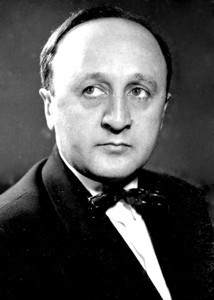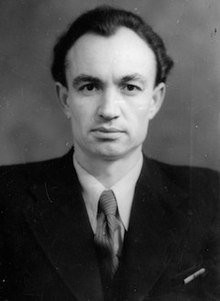
Fikret Amirov |
Fikret Amirov
I saw a spring. Clean and fresh, murmuring loudly, he ran through his native fields. Amirov’s songs breathe freshness and purity. I saw a plane tree. Growing roots deep into the earth, he ascended high into the sky with his crown. Akin to this plane tree is the art of Fikret Amirov, which has risen precisely due to the fact that it has taken root in its native soil. Nabi Hazri

The music of F. Amirov has a great attraction and charm. The composer’s creative heritage is extensive and multifaceted, organically connected with Azerbaijani folk music and national culture. One of the most attractive features of Amirov’s musical language is melodism: “Fikret Amirov has a rich melodic gift,” wrote D. Shostakovich. “Melody is the soul of his work.”
The element of folk music surrounded Amirov from childhood. He was born in the family of the famous tarksta and peztsakhanende (mugham performer) Mashadi Jamil Amirov. “Shusha, where my father was from, is rightfully considered the conservatory of Transcaucasia,” Amirov recalled. “… It was my father who revealed to me the world of sounds and the secret of mughams. Even as a child, I aspired to imitate his tar playing. Sometimes I was good at it and brought great joy. A huge role in the formation of Amirov’s composer’s personality was played by the luminaries of Azerbaijani music – the composer U. Gadzhibekov and the singer Bul-Bul. In 1949, Amirov graduated from the Conservatory, where he studied composition in B. Zeidman’s class. During the years of study at the conservatory, the young composer worked in the folk music classroom (NIKMUZ), theoretically comprehending folklore and the art of mugham. At this time, the young musician’s ardent commitment to the creative principles of U. Gadzhibekov, the founder of Azerbaijani professional music and, in particular, the national opera, is being formed. “I am called one of the successors of Uzeyir Gadzhibekov’s work, and I am proud of this,” Amirov wrote. These words were confirmed by the poem “Dedication to Uzeyir Gadzhibekov” (for unison of violins and cellos with piano, 1949). Under the influence of Gadzhibekov’s operettas (among which Arshin Mal Alan is especially popular), Amirov had the idea to write his own musical comedy The Thieves of Hearts (posted in 1943). The work proceeded under the guidance of U. Gadzhibekov. He also contributed to the production of this work in the State Theater of Musical Comedy, which opened in those difficult war years. Soon Amirov writes a second musical comedy – Good News (posted in 1946). During this period, the opera “Uldiz” (“Star”, 1948), the symphonic poem “In Memory of the Heroes of the Great Patriotic War” (1943), the double Concerto for violin and piano and orchestra (1946) also appeared. In 1947, the composer wrote the Nizami symphony, the first symphony for string orchestra in Azerbaijani music. And finally, in 1948, Amirov created his famous symphonic mughams “Shur” and “Kurd-ovshary”, representing a new genre, the essence of which is the synthesis of the traditions of Azerbaijani folk singers-khanende with the principles of European symphonic music.
“The creation of the symphonic mughams “Shur” and “Kurd-ovshary” is Bul-Bul’s initiative,” noted Amirov, Bul-Bul was “the closest confidante, adviser and assistant of the works I have written so far.” Both compositions make up a diptych, being independent and at the same time connected with each other by modal and intonation kinship, the presence of melodic connections and a single leitmotif. The main role in the diptych belongs to mugham Shur. Both works became an outstanding event in the musical life of Azerbaijan. They received truly international recognition and laid the foundation for the emergence of symphonic maqoms in Tajikistan and Uzbekistan.
Amirov showed himself to be an innovator in the opera Sevil (post. 1953), written based on the drama of the same name by J. Jabarly, the first national lyric-psychological opera. “The drama of J. Jabarly is familiar to me from school,” Amirov wrote. “In the early 30s, in the city drama theater of Ganj, I had to play the role of Sevil’s son, little Gunduz. … I tried to preserve in my opera the main idea of the drama – the idea of the struggle of the woman of the East for her human rights, the pathos of the struggle of the new proletarian culture with the bourgeois bourgeoisie. In the process of working on the composition, the thought of the similarities between the characters of the heroes of the drama by J. Jabarly and Tchaikovsky’s operas did not leave me. Sevil and Tatiana, Balash and Herman were close in their inner warehouse. The national poet of Azerbaijan Samad Vurgun warmly welcomed the appearance of the opera: “…“ Seville ”is rich in enchanting melodies drawn from the inexhaustible treasury of mugham art and skillfully refracted in the opera.”
An important place in the work of Amirov in the 50-60s. occupied by works for a symphony orchestra: the brightly colorful suite “Azerbaijan” (1950), “Azerbaijan Capriccio” (1961), “Symphonic Dances” (1963), imbued with national melos. The line of symphonic mughams “Shur” and “Kurd-ovshary” after 20 years is continued by Amirov’s third symphonic mugham – “Gulustan Bayaty-shiraz” (1968), inspired by the poetry of two great poets of the East – Hafiz and Behind. In 1964, the composer made the second edition of the symphony for string orchestra “Nizami”. (The poetry of the great Azerbaijani poet and thinker later inspired him to create the ballet “Nizami”.) On the occasion of the 600th anniversary of another outstanding Azerbaijani poet, Nasimi, Amirov writes a choreographic poem for a symphony orchestra, women’s choir, tenor, reciters and ballet troupe “The Legend of Nasimi”, and later makes an orchestral version of this ballet.
A new peak in Amirov’s work was the ballet “A Thousand and One Nights” (post. 1979) – a colorful choreographic extravaganza, as if radiating the magic of Arab fairy tales. “At the invitation of the Ministry of Culture of Iraq, I visited this country with N. Nazarova” (choreographer-director of the ballet. – N.A.). I tried to penetrate deeply into the musical culture of the Arab people, its plasticity, the beauty of musical rituals, studied historical and architectural monuments. I was faced with the task of synthesizing the national and universal…” wrote Amirov. The score of the ballet is brightly colored, based on the play of timbres imitating the sound of folk instruments. Drums play an important role in it, they carry an important semantic load. Amirov introduces another timbre color into the score – a voice (soprano) singing the theme of love and becoming a symbol of the ethical principle.
Amirov, along with composing, was actively involved in musical and social activities. He was the secretary of the boards of the Union of Composers of the USSR and the Union of Composers of Azerbaijan, artistic director of the Azerbaijan State Philharmonic Society (1947), director of the Azerbaijan Academic Opera and Ballet Theater named after. M. F. Akhundova (1956-59). “I have always dreamed and still dream that Azerbaijani music will be heard in all corners of the globe… After all, people judge themselves by the music of the people! And if at least partially I managed to fulfill my dream, the dream of my whole life, then I am happy,” Fikret Amirov expressed his creative credo.
N. Aleksenko





